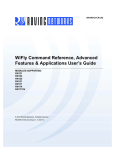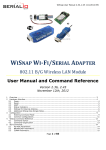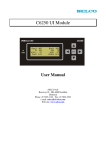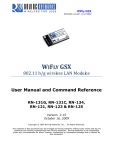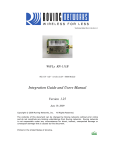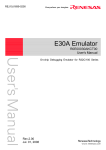Download I/O DLL Kit User`s Manual
Transcript
REJ10J1510-0100
I/O DLL Kit
User's Manual
Simulator Debugger Customizing Kit
Rev.1.00
Nov. 01, 2006
Notes regarding these materials
1. This document is provided for reference purposes only so that Renesas customers may select the appropriate
Renesas products for their use. Renesas neither makes warranties or representations with respect to the
accuracy or completeness of the information contained in this document nor grants any license to any
intellectual property rights or any other rights of Renesas or any third party with respect to the information in
this document.
2. Renesas shall have no liability for damages or infringement of any intellectual property or other rights arising
out of the use of any information in this document, including, but not limited to, product data, diagrams, charts,
programs, algorithms, and application circuit examples.
3. You should not use the products or the technology described in this document for the purpose of military
applications such as the development of weapons of mass destruction or for the purpose of any other military
use. When exporting the products or technology described herein, you should follow the applicable export
control laws and regulations, and procedures required by such laws and regulations.
4. All information included in this document such as product data, diagrams, charts, programs, algorithms, and
application circuit examples, is current as of the date this document is issued. Such information, however, is
subject to change without any prior notice. Before purchasing or using any Renesas products listed in this
document, please confirm the latest product information with a Renesas sales office. Also, please pay regular
and careful attention to additional and different information to be disclosed by Renesas such as that disclosed
through our website. (http://www.renesas.com )
5. Renesas has used reasonable care in compiling the information included in this document, but Renesas
assumes no liability whatsoever for any damages incurred as a result of errors or omissions in the information
included in this document.
6. When using or otherwise relying on the information in this document, you should evaluate the information in
light of the total system before deciding about the applicability of such information to the intended application.
Renesas makes no representations, warranties or guaranties regarding the suitability of its products for any
particular application and specifically disclaims any liability arising out of the application and use of the
information in this document or Renesas products.
7. With the exception of products specified by Renesas as suitable for automobile applications, Renesas
products are not designed, manufactured or tested for applications or otherwise in systems the failure or
malfunction of which may cause a direct threat to human life or create a risk of human injury or which require
especially high quality and reliability such as safety systems, or equipment or systems for transportation and
traffic, healthcare, combustion control, aerospace and aeronautics, nuclear power, or undersea communication
transmission. If you are considering the use of our products for such purposes, please contact a Renesas
sales office beforehand. Renesas shall have no liability for damages arising out of the uses set forth above.
8. Notwithstanding the preceding paragraph, you should not use Renesas products for the purposes listed below:
(1) artificial life support devices or systems
(2) surgical implantations
(3) healthcare intervention (e.g., excision, administration of medication, etc.)
(4) any other purposes that pose a direct threat to human life
Renesas shall have no liability for damages arising out of the uses set forth in the above and purchasers who
elect to use Renesas products in any of the foregoing applications shall indemnify and hold harmless Renesas
Technology Corp., its affiliated companies and their officers, directors, and employees against any and all
damages arising out of such applications.
9. You should use the products described herein within the range specified by Renesas, especially with respect
to the maximum rating, operating supply voltage range, movement power voltage range, heat radiation
characteristics, installation and other product characteristics. Renesas shall have no liability for malfunctions or
damages arising out of the use of Renesas products beyond such specified ranges.
10. Although Renesas endeavors to improve the quality and reliability of its products, IC products have specific
characteristics such as the occurrence of failure at a certain rate and malfunctions under certain use
conditions. Please be sure to implement safety measures to guard against the possibility of physical injury, and
injury or damage caused by fire in the event of the failure of a Renesas product, such as safety design for
hardware and software including but not limited to redundancy, fire control and malfunction prevention,
appropriate treatment for aging degradation or any other applicable measures. Among others, since the
evaluation of microcomputer software alone is very difficult, please evaluate the safety of the final products or
system manufactured by you.
11. In case Renesas products listed in this document are detached from the products to which the Renesas
products are attached or affixed, the risk of accident such as swallowing by infants and small children is very
high. You should implement safety measures so that Renesas products may not be easily detached from your
products. Renesas shall have no liability for damages arising out of such detachment.
12. This document may not be reproduced or duplicated, in any form, in whole or in part, without prior written
approval from Renesas.
13. Please contact a Renesas sales office if you have any questions regarding the information contained in this
document, Renesas semiconductor products, or if you have any other inquiries.
Overview
The I/O DLL kit is provided for the purpose of extending the functions of the Simulator Debuggers. Microsoft
Visual C++, a Windows application development environment available on the market, is needed to create I/O
DLLs.
This user’s manual shows the basic information necessary to use the I/O DLL kit. For details about the language
specifications of and the method for using Visual C++, refer to the user's manual included with your product or
online help.
Supported Simulator Debuggers
The I/O DLL kit cannot be used in all of the Simulator Debuggers. For the Simulator Debuggers and their
versions which can be run in conjunction with the I/O DLL kit, refer to the release notes for the I/O DLL kit in
which they are detailed.
Rights to use
The rights to use the I/O DLL kit come under the provisions of the Software License Agreement for the
Simulator Debuggers used. Please also be aware that the I/O DLL kit can only be used in developing your
product, and cannot be used for any other purpose.
Technical support
Please note that technical support for the I/O DLL kit can be obtained by visiting our homepage (URL:
http://www.renesas.com/en/tools) at which latest information is available.
Active X, Microsoft, MS-DOS, Visual Basic, Visual C++, Windows and Windows NT are either registered trademarks or
trademarks of Microsoft Corporation in the United States and other countries.
IBM and AT are registered trademarks of International Business Machines Corporation.
Intel and Pentium are registered trademarks of Intel Corporation.
Adobe and Acrobat are registered trademarks of Adobe Systems Incorporated.
All other brand and product names are trademarks, registered trademarks or service marks of their respective holders.
[MEMO]
Contents
Contents
1.
ABSTRACT .................................................................................................................................................. 1
2.
CONFIGURATION ..................................................................................................................................... 1
3.
METHOD FOR CREATING THE I/O DLL ............................................................................................. 2
3.1.
METHOD FOR USING THE IODLLTEMPLATE PROJECT............................................................................... 2
3.2.
METHOD FOR CREATING THE NEW I/O DLL............................................................................................ 3
4.
METHOD FOR USING THE I/O DLL...................................................................................................... 5
5.
METHOD FOR DEBUGGING THE I/O DLL.......................................................................................... 6
6.
FUNCTIONS THAT SEND INFORMATION TO THE I/O DLL .......................................................... 7
7.
FUNCTIONS THAT GET INFORMATION FROM SIMXX.EXE ...................................................... 11
8.
NOTES......................................................................................................................................................... 17
i
Contents
[MEMO]
ii
I/O DLL Kit
1. Abstract
I/O DLL means a Dynamic Link Library (DLL) that operates in conjunction with the simulator engine of the
Simulator Debugger.
The Simulator Debugger when properly set up can load an I/O DLL, and can operate it synchronously with the
timing at which the program executes one instruction, read/writes to memory or generates an interrupt.
This allows to debug the target program by simulating the operation of the microcomputer’s input/output ports
or internal peripheral functions. This also makes data input/output and other linked operations with external
tools possible.
Any desired I/O DLL can be created using C/C++ languages. Microsoft Visual C++, a Windows application
development environment available on the market, is needed to create I/O DLLs.
2. Configuration
The I/O DLL accesses the simulator engine simxx.exe (xx denotes the model name such as 308 or 30) to
obtain information on memory or register values, etc.
In turn, simxx.exe notifies the I/O DLL of various information including memory read/write information and
the number of cycles in which the program executed each instruction.
The simulator debugger and the I/O DLL are configured in the manner shown below.
Simulator Debugger
HEW Debugger GUI
(Front End)
Notifies the information to I/O DLL
from simxx.exe.
• The number of cycles of the
executed instruction
• The timing of resetting
• R/W information of memory.
etc.
I/O DLL
simxx.exe
(Simulator Engine)
(Create)
Puts/gets the information to simxx.exe
from I/O DLL.
• Puts/gets the memory value, the register value.
• The Interrupt generation, The verification of
the interrupt generation conditions.
• The stopping of execution of the target program.
etc.
1
I/O DLL Kit
3.
Method for Creating the I/O DLL
This chapter describes how to create I/O DLLs using Microsoft Visual C++ 6.0 (hereafter abbreviated VC++).
For details on how to use VC++, see the VC++ user’s manual or help.
An I/O DLL may be created by making use of the I/O DLL sample project “IodllTemplate” which is included
with the I/O DLL kit or newly from scratch. The IodllTemplate project is a VC++ template project provided
for creating I/O DLLs.
3.1. Method for Using the IodllTemplate project
The following explains how to create I/O DLLs from the IodllTemplate project by using an I/O DLL for
Simulator Debugger for M32C Series as an example. To create I/O DLLs for other simulator models, change
the model name “308” described here with any desired model name (e.g., “100” or “30”).
1.
Choose “Open Workspace…” from the File menu of VC++. Open the project file “IodllTemplate.dsp”
for the IodllTemplate project which is stored in a directory under the directory in which the I/O DLL
package is installed (hereafter referred to as C:¥Renesas¥Iodll).
”Samples¥PDxxSIM¥IodllTemplate"
2.
Choose “Setting…” from the Project menu of VC++. Check path settings for the I/O DLL library files
sim308.lib and IodllExpLib(d).lib which are specified in the “Object/library modules:” column of the
category “General” on the Link tab. (The file locations must be specified using absolute or relative
paths.) These library files are stored in the “Library” directory of C:¥Renesas¥Iodll.
3.
•
If settings are made for Win32 Debug, specify IodllExpLibd.lib.
•
If settings are made for Win32 Release, specify IodllExpLib.lib.
Choose “Setting…” from the Project menu of VC++. Change the I/O DLL filename
“IodllTemplate.dll” which is specified in the “Output file name:” column of the category “General” on
the Link tab to another filename you want (extension “.dll”) so that the I/O DLL output destination is
the directory in which you installed Simulator Debugger.
Note that the Simulator Debugger is stored in the directory shown below:
HEW install directory
¥Tools¥Renesas¥DebugComp¥Platform¥PDTarget¥PD308SIM
Example: Output file name:
C:¥Program Files¥Renesas¥HEW¥Tools¥Renesas¥DebugComp¥Platform¥
PDTarget¥PD308SIM¥sample.dll
2
I/O DLL Kit
4.
Open infunc¥iofunc.cpp, then write the code for simulation. The infunc¥iofunc.cpp has implemented
in it the functions called from sim308.exe. Use a function that accesses sim308.exe in the desired
function as you write the code for simulation.
5.
When you build, an I/O DLL (sample.dll) is created.
3.2. Method for Creating the new I/O DLL
To create a new I/O DLL without using the IodllTemplate project, follow the procedure described below.
1.
Choose “New…” from the File menu of VC++. Then create a new project with settings shown below.
• Select MFC AppWizard (dll) on the Projects tab.
• Set any project name and location. (Example: “sample” project)
• Choose “Create new workspace”.
• Check Win32 in the “Platforms:”.
• Click the [OK]->[Close].
3
I/O DLL Kit
2.
Choose “Setting…” from the Project menu of VC++ and enter the settings described below.
• Select the C/C++ tab and add a definition “IODLL_EXPORTS” to the “Preprocessor definitions:”
column of the category “General.”
• Select the Link tab and specify the I/O DLL library files sim308.lib and IodllExpLib(d).lib using
absolute or relative paths in the “Object/library modules:” column of the category “General.” These
library files are stored in the “Library” directory of C:¥MTOOL¥Iodll.
3.
-
If settings are made for Win32 Debug, specify IodllExpLibd.lib.
-
If settings are made for Win32 Release, specify IodllExpLib.lib.
Choose “Setting…” from the Project menu of VC++. Set the “Output file name:” column of the
category “General” on the Link tab so that the I/O DLL output destination is the directory in which
you installed Simulator Debugger.
Example: Output file name:
C:¥Program Files¥Renesas¥HEW¥Tools¥Renesas¥DebugComp¥Platform¥
PDTarget¥PD308SIM¥sample.dll
4.
Copy iofunc.cpp and iofunc.h from the “iofunc” directory of the IodllTemplate project into any
directory of the new project you’ve created, and add them to the project following the procedure
described below.
• Choose “Add To Project” – “Files…” from the Project menu of VC++, select iofunc.cpp from the
ensuing list, and click OK.
5.
Open infunc.h and change the main header file specification for the application included in it to the
new main header filename you’ve created.
Example: #include "..¥IodllTemplate.h" -> “#include "..¥sample.h"
6.
Open iofunc.cpp, then write the code for simulation.
7.
When you build, an I/O DLL (sample.dll) is created.
4
I/O DLL Kit
4. Method for Using the I/O DLL
This chapter describes how to use an I/O DLL in the Simulator Debugger after loading it.
Before you can use an I/O DLL, you must first register it to simxx.exe.
If simxx.exe has an I/O DLL registered in it when you start, it loads the registered I/O DLL before starting
simulation.
The following explains how to use an I/O DLL after registering it to the Simulator Debugger by using
Simulator Debugger for M32C Series as an example. To use I/O DLLs for other simulator models, change the
model name “308” described here with any desired model name (e.g., “100” or “30”).
1.
Copy the I/O DLL file (.dll file) you want to use into the directory in which you installed Simulator
Debugger.
Note that the Simulator Debugger is stored in the directory shown below:
HEW install directory
¥Tools¥Renesas¥DebugComp¥Platform¥PDTarget¥PD308SIM
2.
Register the I/O DLL to simxx.exe. To do this, write the I/O DLL filename in sim308.exe’s environment
setup file “sim308.ini.”
The sim308.ini file exists in the directory in which you installed Simulator Debugger. However,
this file is nonexistent if you have never started Simulator Debugger since you installed it. In that case,
this file needs to be newly created using an editor.
3.
In the sim308.ini file, create a [DLLNAME] section and write an I/O DLL filename after “IODLL=,” with
the extension “.dll” removed as shown below.
Example: When an I/O DLL file name is "Sample.dll".
[DLLNAME]
IODLL=Sample
4.
When you start Simulator Debugger, the I/O DLL is loaded.
If you do not use the I/O DLL, delete the description of the [DLLNAME] section that you created in the
sim308.ini file before starting Simulator Debugger.
[DLLNAME]
<- Delete
IODLL=Sample
<- Delete
5
I/O DLL Kit
5. Method for Debugging the I/O DLL
This chapter describes how to debug the I/O DLL you’ve created.
To debug the I/O DLL in VC++, you need to change settings of the I/O DLL project. The following shows the
contents of changes you need to make by using the case of debugging an I/O DLL for Simulator Debugger for
M32C Series as an example. To debug I/O DLLs for other simulator models, change the model name “308”
described here with any desired model name (e.g., “100” or “30”).
1.
Following the procedure described in the preceding section, register the I/O DLL to make it usable.
2.
Choose “Setting…” from the Project menu of VC++. Set the “Output file name:” column of the
category “General” on the Link tab so that the I/O DLL output destination is the directory in which
you installed Simulator Debugger.
Example: Output file name:
C:¥Program Files¥Renesas¥HEW¥Tools¥Renesas¥DebugComp¥Platform¥
PDTarget¥PD308SIM¥sample.dll
3.
Choose “Setting…” from the Project menu of VC++. Set up the “Executable for debug session:”
column on the Debug tab so that the simulator engine executable file “sim308.exe” stored in the
directory in which you installed Simulator Debugger becomes the debug-time executable file.
Example: Executable for debug session:
C:¥Program Files¥Renesas¥HEW¥Tools¥Renesas¥DebugComp¥Platform¥
PDTarget¥PD308SIM¥sim308.exe
4.
After you finished setting up, choose “Start Debug” -- “Go” from the Build menu of VC++ to start
debugging. The message shown below will appear.
“sim308.exe does not contain debugging information. Press OK to continue.”
Because the I/O DLL can be debugged, click OK to continue.
5.
To debug the I/O DLL, start Simulator Debugger after the simulator engine sim308.exe has started
up. (After sim308.exe started up, it is registered (displayed) in the Windows system tray. So you can
see that sim308.exe is up and running before you start Simulator Debugger.)
For details the debugging function of VC++, see the VC++ user’s manual or help.
6
I/O DLL Kit
6. Functions that Send Information to the I/O DLL
This chapter describes specifications of the functions that send information on the simulator engine side to the
I/O DLL.
These functions are implemented in the I/O DLL project’s source file “iofunc¥iofunc.cpp.” The simulator
engine simxx.exe calls these functions as it sends information to the I/O DLL. Make sure codes for simulation
are written in these functions.
Function name
NotifyStepCycle
NotifyPreExecutionPC
NotifyReset
NotifyStart
NotifyEnd
NotifyInterrupt
NotifyPreReadMemory
NotifyPostWriteMemory
Abstract
Notifies the number of execution cycles each time an instruction is executed.
Notifies the current PC value immediately before executing an instruction.
Notifies that the target program was reset.
Notifies that the simulator engine was started.
Notifies that the simulator engine was terminated.
Notifies the vector number (vector address) for an interrupt when that
interrupt was generated.
Notifies the read address and data length immediately before reading from
memory when a memory read from the target program occurred.
Notifies the write address, data length and data value after data was written
from the target program to memory.
Below shows a specification of the function.
z
Notifies the number of execution cycles an instruction is executed
Function name: void NotifyStepCycle(int cycle)
Parameter:
int cycle The number of the executed cycles.
Return value: None
Functions:
z
Notifies the number of execution cycles each time an instruction is executed.
Notifies the current PC value before executing an instruction
Function name: void NotifyPreExecutionPC(unsigned long address)
Parameter:
unsigned long address
PC value before executing
Return value: None
Functions:
z
Notifies the current PC value immediately before executing an instruction.
Notifies the reset
Function name: void NotifyReset(void)
Parameter:
None
Return value: None
Functions:
Notifies that the target program was reset.
7
I/O DLL Kit
z
Notifies the start of simulator engine
Function name: void NotifyStart(void)
Parameter:
None
Return value: None
Functions:
z
Notifies that the simulator engine was started.
Notifies the terminate of simulator engine
Function name: void NotifyEnd(void)
Parameter:
None
Return value: None
Functions:
z
Notifies that the simulator engine was terminated.
Notifies the generate of interrupt
Function name: void NotifyInterrupt(unsigned long vec)
Parameter:
unsigned long vec
Vector number.
Return value: None
Functions:
z
Notifies the vector number for an interrupt when that interrupt was generated.
Notifies immediately before reading from memory
Function name: void NotifyPreReadMemory(unsigned long address, int length)
Parameter:
unsigned long address
int length
Memory address.
Data length of memory data.
1
1 byte
2
2 byte
3
3 byte
4
4 byte
Return value: None
Functions:
Notifies the read address and data length immediately before reading from memory when a
memory read from the target program occurred.
8
I/O DLL Kit
z
Notifies after data was written from memory
Function name: void NotifyPostWriteMemory(unsigned long address, int length, unsigned long data)
Parameter:
unsigned long address
int length
Memory address.
Data length of memory data.
1
1 byte
2
2 byte
3
3 byte
4
4 byte
unsigned long data Memory data value.
Return value: None
Functions:
Notifies the write address, data length and data value after data was written from the target
program to memory.
9
I/O DLL Kit
The following shows an example of how to write the above functions. The shaded sections in this example are
the template part of the above functions that are implemented in the iofunc.cpp file.
void NotifyStepCycle(int cycle)
{
unsigned long tabsrData, ta0Data, ta0icData;
if (sCountFlag == FALSE) {
// Check on count beginning flag.
return;
}
RequestGetMemory(TABSR, 1, &tabsrData);
if ((tabsrData & 0x01) == 0x01) {
// Check on count beginning flag.
sCountCycle += cycle;
RequestGetMemory(TA0, 2, &ta0Data);
if (sCountCycle >= ta0Data + 1) {
// Count down of counter.
RequestGetMemory(TA0IC, 1, &ta0icData);
RequestInterrupt(TA0INT, ta0icData & 0x7);
// Generation of timer A0 interrupt.
sCountCycle = 0;
}
}
return;
}
void NotifyPreExecutionPC(unsigned long address)
{
return;
}
:
:
:
void NotifyPostWriteMemory(unsigned long address, int length)
{
if (address == TABSR) {
if ((data & 0x01) == 0x01) {
// Check on count beginning flag.
sCountFlag = TRUE;
}
}
return;
}
10
I/O DLL Kit
7. Functions that Get Information from simxx.exe
This chapter describes specifications of the functions that get information on the simulator engine side from
the I/O DLL.
These functions are implemented on the simxx.exe side. The I/O DLL calls these functions to get information
from the simulator engine. Use these functions to write codes for simulation within the functions implemented
in the I/O DLL project’s source file “iofunc¥iofunc.cpp.”
Function name
RequestGetMemory
RequestPutMemory
RequestGetRegister
RequestPutRegister
RequestInterrupt
RequestInterruptStatus
RequestTotalCycle
RequestInstructionNum
RequestStop
RequestErrorNum
Abstract
Gets memory data from the specified address.
Sets memory data at the specified address.
Gets a value from the specified register.
Sets a value in the specified register.
Generates a specified interrupt.
Gets the status of generated interrupts.
Inspects a total number of current execution cycles.
Inspects a total number of currently executed instructions.
Causes the target program to stop running.
Gets an error number when an error occurred in the immediately preceding
function that was executed.
Below shows a specification of the function.
z
Gets memory data
Function name: int RequestGetMemory(unsigend long address, int length, unsigend long * data)
Parameter:
unsigned long address
int length
Memory address.
Data length of memory data.
1
1 byte
2
2 byte
3
3 byte
4
4 byte
unsigned long * data
Memory data storage area.
Return value: int status
Functions:
TRUE
Succeeded.
FALSE
Error.
Gets memory data from the specified address.
The read access information performed by this function is not reflected in the virtual port
input and I/O script facilities.
11
I/O DLL Kit
z
Sets memory data
Function name: int RequestPutMemory(unsigend long address, int length, unsigend long data)
Parameter:
unsigned long address
int length
Memory address.
Data length of memory data.
1
1 byte
2
2 byte
3
3 byte
4
4 byte
unsigned long data Memory data.
Return value: int status
Functions:
TRUE
Succeeded.
FALSE
Error.
Sets memory data at the specified address.
The write access information performed by this function is not reflected in the GUI output,
virtual port output and I/O script facilities.
12
I/O DLL Kit
z
Gets register value
Function name: int RequestGetRegister(int regNo, unsigned long * regValue)
Parameter:
int regNo Register number.
For register numbers, see the header file “iofunc¥iofunc.h” that is included in the
I/O DLL sample program. Register numbers are defined in this file.
Example: Definition for PD308SIM.
regNo
REG_Rx_F
REG_RxH_F
REG_RxL_F
REG_Ax_F
REG_FB_F
REG_SB_F
REG_Rx_R
REG_RxH_R
REG_RxL_R
REG_Ax_R
REG_FB_R
REG_SB_R
REG_Rx
REG_RxH
REG_RxL
REG_Ax
REG_FB
REG_SB
REG_USP
REG_ISP
REG_FLG
REG_PC
REG_INTB
REG_SVF
REG_SVP
REG_VCT
REG_DMDx
REG_DCTx
REG_DRCx
REG_DMAx
REG_DSAx
REG_DRAx
Register
Bank0 Rx registers. (x = 0 to 3)
High-order 8 bits of the Bank0 Rx register. (x = 0 to 1)
Low-order 8 bits of the Bank0 Rx register. (x = 0 to 1)
Bank0 Ax registers. (x = 0 to 1)
Bank0 FB register.
Bank0 SB register.
Bank1 Rx registers. (x = 0 to 3)
High-order 8 bits of the Bank1 Rx register. (x = 0 to 1)
Low-order 8 bits of the Bank1 Rx register. (x = 0 to 1)
Bank1 Ax register. (x = 0 to 1)
Bank1 FB register.
Bank1 SB register.
Rx register indicated by the B flag. (x = 0 to 3)
High-order 8 bits of the Rx register indicated by the B flag.
(x = 0 to 1)
Low-order 8 bits of the Rx register indicated by the B flag.
(x = 0 to 1)
Ax register indicated by the B flag. (x = 0 to 1)
FB register indicated by the B flag.
SB register indicated by the B flag.
USP register.
ISP register.
FLG register.
Program counter.
INTB register.
SVF register.
SVP register.
VCT register.
DMDx registers. (x = 0 to 1)
DCTx registers. (x = 0 to 1)
DRCx registers. (x = 0 to 1)
DMAx registers. (x = 0 to 1)
DSAx registers. (x = 0 to 1)
DRAx registers. (x = 0 to 1)
Description example: To get the R0 register value in bank 0
RequestGetRegister( REG_R0_F, ®Value );
unsigned long * regValue
Register value storage area.
13
I/O DLL Kit
Return value: int status
Functions:
z
TRUE
Succeeded.
FALSE
Error.
Gets a value from the specified register.
Sets a register value
Function name: int RequestPutRegister(int regNo, unsigned long regValue)
Parameter:
int regNo
Register number.
unsigned long regValue
Register value.
Return value: int status
Functions:
z
TRUE
Succeeded.
FALSE
Error.
Sets a value in the specified register.
Generates a interrupt
Function name: int RequestInterrupt(unsigned long vec, int ipl)
Parameter:
unsigned long vec
int ipl
Return value: int
Functions:
z
Vector number.
Priority.
status
TRUE
Succeeded.
FALSE
Error.
Generates a specified interrupt.
Gets the status of generated interrupts
Function name: int RequestInterruptStatus(unsigned long * vec)
Parameter:
unsigned long * vec Vector number.
Return value: int happen
Functions:
Generation status of interrupt.
TRUE
Generated. Vector number are stored in vec.
FALSE
Un-generated. Vec is indeterminate.
Gets the status of generated interrupts.
14
I/O DLL Kit
z
Inspects a total number of execution cycles
Function name: void RequestTotalCycle(unsigned long * cycle)
Parameter:
unsigned long * cycle
A total number of execution cycles.
Return value: None
Functions:
z
Inspects a total number of current execution cycles.
Inspects a total number of executed instructions.
Function name: void RequestInstructionNum(unsigned long * inst)
Parameter:
unsigned long * inst
A total number of currently executed instructions.
Return value: None
Functions:
z
Inspects a total number of currently executed instructions.
Causes the target program to stop running
Function name: void RequestStop(void)
Parameter:
None
Return value: None
Functions:
Causes the target program to stop running.
15
I/O DLL Kit
z
Gets error information
Function name: int RequestErrorNum(void)
Parameter:
None
Return value: int errNum
errNom
000
001
002
003
004
005
100
101
200
201
202
Functions:
Error number.
Contents
No error.
Address value is out of range.
Can't read/write, because there are no memory at that area.
Can't get enough memory.
Data size is out of range.
Can't access a specified address.
Description of register is illegal.
Data value is illegal.
Specified vector out of range.
Specified level of priority out of range.
Can't get enough memory.
Gets an error number when an error occurred in the immediately preceding function that
was executed.
This function allows to get information on what error occurred when one of the following
functions was called and its returned value was false.
• RequestGetMemory function
• RequestPutMemory function
• RequestGetRegister function
• RequestPutRegister function
• RequestInterrupt function
Use example:
unsigned long data;
char
str[5];
if ( RequestGetMemory( 0x800, 4, data ) == FALSE ) {
sprintf( str, "%d", RequestErrorNum() );
MessageBox( NULL, str, "Error number", MB_OK );
// Display error number to message box.
}
16
I/O DLL Kit
The following shows an example of how to write the above functions. The shaded sections in this example are
the template part of the above functions that are implemented in the iofunc.cpp file.
void NotifyPostWriteMemory(unsigned long address, int length, unsigned long data)
{
if (address == 0x3e0) {
RequestGetRegister(REG_PC, &val);
// Get PC Value.
RequestPutMemory(0x800, 4, val);
// Store PC value in 0x800 address.
} else if (address == 0x3e1) {
RequestPutRegister(REG_R0_F, data);
// Store value in bank0 R0 register.
RequestInterrupt(21, 7);
// Generation of timer A0 interrupt.
}
return;
}
8.
Notes
1. Changes of values input/output to or from memory using the I/O DLL cannot be referenced using the GUI
output, virtual port input/output or I/O script facilities of Simulator Debugger.
2. Only one I/O DLL can be specified in Simulator Debugger. You cannot specify multiple I/O DLLs.
17
I/O DLL Kit
[MEMO]
18
I/O DLL Kit
User's Manual
Publication Date:
Nov. 01, 2006
Rev.1.00
Published by:
Sales Strategic Planning Div.
Renesas Technology Corp.
Edited by:
Microcomputer Tool Development Department
Renesas Solutions Corp.
© 2006. Renesas Technology Corp. and Renesas Solutions Corp., All rights reserved. Printed in Japan.
I/O DLL Kit
User's Manual






























